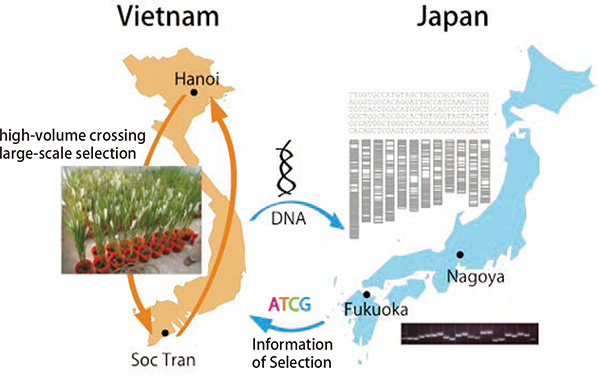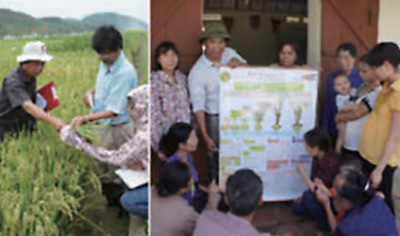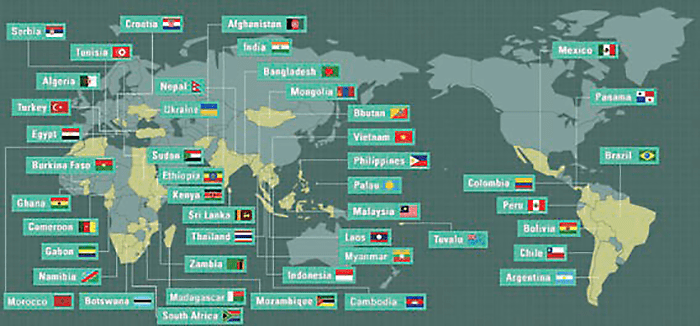Research Results
Resolve food issues with science & technology cooperation beyond the borders
Japan's state-of-the-art rice breeding technology creates new varieties for needs of Vietnam FY2017

- Atsushi Yoshimura (Professor, Faculty of Agriculture, Graduate School, Kyushu University)
- SATREPS
- "Bioresources Field Development of Crop Genotypes for Midlands and Mountain Areas of North Vietnam" Principal Investigator 2010-2015)
Improvement of food self-sufficiency by Japan's rice genome science & technology
The Vietnamese economy has shown remarkable growth in recent years, but the nation' s northern region and other rural areas still face problems such as food shortages and income disparity.
In particular, food self-sufficiency is low in the mountainous regions of the north, and some region suitable only for single cropping because of its geographical features such as the cool climate, and the harvest of rice is small. People living in the se regions have been suffering from chronic food shortages for many years. Applying efficient breeding technologies that lever - age rice genomics, an area in which Japan excels, the project has succeeded in developing new promising lines of ri ce that have short growing periods and high yields, and are resistance to disease and insect pests. Further, in addition to its aims to e stablish cultivation methods in these regions using the newly developed varieties, the project has engaged in efforts to introduce the new varieties, with the major goal of raising f ood self-sufficiency in Vietnam.

The beginning of Prof. Yoshimura started the project in Viet- nam dates back 20 years. At that time, the faculty of agriculture at Kyushu University and Vietnam National University of Agricul- ture (formerly Hanoi University of Agriculture) were closely con- nected in terms of research and development as well as personnel exchange due to the technical cooperation project (1998-2003), implemented through collaboration with ODA by Japan International Cooperation Agency (JICA). A firm research network had been built, helping to nurture a strong bond between the researchers of both countries. It was on such a foun- dation that the SATREPS initiative had been launched.
Extending the next generation type of rice breeding system based on the genome information
Project team combined the DNA marker breeding technology with the favorable conditions of Vietnam' s geography to succeed in developing an efficient rice breeding system in which a spill- over effect can be expected. The breeding system created through this project is highly mobile, putting together a large volume of backcrossing, DNA marker selection and accelerated generation in a compact way. It is hoped that utilizing and extending rice breeding techniques based on the needs of nations of ASEAN in the future. If it' s achieved, the potential for future spin off effects must be huge.
In addition, the breeding system created in this project was used along with useful genes and DNA marker information pro- vided by Kyushu University and Nagoya University to develop multiple lines (approx. 50 lines) of promising rice cultivars that possess a single or multiple useful genes and are short in growth period, high yield as well as pest and disease resistant. A cultiva- tion method suited for promising lines was also established.
Succeeded in developing new varieties of rice breeding in Vietnam
This project is investigating the cultivation characteristics and physiological and ecological properties of promising lines of rice, with the aim of registering the promising lines that have been developed as new rice varieties. Registration has been completed on some lines and the introduction of those varieties to farmers is well under way. Developing new rice varieties is a major under- taking that involves not only scientific backing, but also the efforts of government, farmers, and seed suppliers, among others. Definite steps are being taken to implementing them into the community.
In particular, new varieties with short growing periods that have been developed in this project have mitigated flood and typhoon damage on rice crops suffered by farmers in Northern Vietnam, and they are also having a major impact on agricultural policy.
Research Supervisors at SATREPS have overall responsibility for research in a specific research area, also giving guidance & advice concerning the research as necessary.
As Prof. Yoshimura says, their advice when we started the proj- ect at the field is invaluable to steadily promote for internation- al joint research and it worked effectively owing to the entirely new type of the program that combines official development assistance (ODA) with competitive research funding in the fields of science and technology.

(left) Selection process in the field (right) Teaching local farmers about the new varieties
Science and Technology Research Partnership for Sustainable Development (SATREPS)
SATREPS is a Japanese government program structured as a collaboration among JST, AMED and JICA. Based on the needs of developing countries, we cooperate to promote international joint research targeting global issues with an objective of future utilization of research outcomes.
Implemented through collaboration with the Official Devel- opment Assistance (ODA), the aim of this program is to acquire new knowledge and technology that lead to the resolution of global issues and advance of science & technology, and to create innovations through this process.
International joint research under this program also aims to enhance the research & development capabilities of partner countries, and helps create sustainable research systems able to address the issues.
(115 projects in 46 countries have been adopted since April, 2008)

